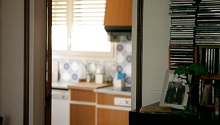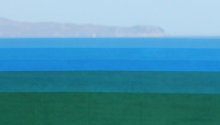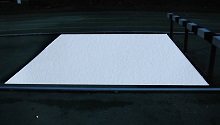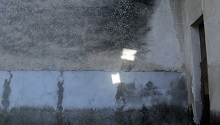Job Ramos
Job Ramos i Perramon (Olot, 1974) has Fine Arts degrees from Barcelona University and the University of West England, Bristol. He works in the field of installation, video, sound and performance.
He has had solo shows at the Sala Montcada and Metrònom (Barcelona), Fundació Espais, Bòlit Centre d’Art Contemporani and Casa de Cultura (Girona), Sala H (Vic), Espacio Abisal (Bilbao), Espai Zer01 (Olot), and Yeans (Sweden), among others.
His group shows include AARA (Bangkok), La Capella and Centre d’Art Santa Mònica (Barcelona), CA2M and INJUVE (Madrid), The Hole Mindpirates (Berlin), Matucana 100 (Chile), Centro de la Imagen (Mexico), Cornell University (New York), Turku (Finland), and Konstall “C” (Sweden). He has also submitted projects to competitions such as Sónar, OVNI, and Arco electrónico.
Program in collaboration with LOOP Festival.
The themes of this year’s LOOP festival centre on the treatment of relations between art and film. In this context, the Festival has selected two works to show in May and June (coinciding with LOOP 2016) and Pantalla CCCB. The works chosen for this collaboration are Inversió d’un pla, by Job Ramos, screening throughout May, and Louis Garrel, by Irene Solà, in June. Both are cues for discussion of the presence of film in the eyes looking through the camera at the everyday. This presence is a force that conditions the perception of the artist’s surroundings, and the work becomes a reflection of it.
The images in Inversió d’un pla are the result of trying out a camera. In a common procedure, Ramos filmed what he knew—his home, the Garrotxa landscape he could see from his window and his family—to find out how the device worked. The editing of the images in Inversió d’un pla and the accompanying music generate a clear parallel with the opening minutes of the film Aguirre, Wrath of God (1972) by German filmmaker and documentarist Werner Herzog.
I don’t know if the first time Herzog used a video camera it was at home. What I do know is that one of his best-known films, Aguirre, Wrath of God, was also one of his first features, made in the Amazon jungle with the help of a large crew. One member who contributed to this great production was a camera technician by the name of Francisco Joan, according to the film credits. On reading this, Ramos remembered Paco, a man from his village who talked about working as a cameraman for some director, somewhere in the world. A few phone calls later, Ramos established that Paco and Francisco Joan were one and the same.
The German director’s film was about Spanish conquistadores who set out on a hazardous journey up the Amazon River to find El Dorado, that vague, mythical kingdom always out of reach, created by the European newcomer to that side of the Atlantic. This was the figure of Mary Louise Pratt’s “seeing-man”. Subject to the European landscape discourse, he looks passively out, judges and possesses. Various genocides and several centuries later, someone showed the West that its travel literature, rather than offering a faithful portrait of the reality of the other, was a definition of the West itself. The existence of El Dorado in the collective imaginary is, then, thanks to the literary, visual and cinematographic representations that have been made of it, especially significant if we see it as a phantasm bearing the greatest dreams and riches that man has been able to imagine and pursue when faced with a text written in a language he did not understand and, after erasing the signs, christened it “New World”. I don’t know if anyone ever reached that El Dorado, but Herzog did not venture to represent it in any other way than the deictic words and the crimes of his characters. Perhaps this was due to his habit of trying to film things truthfully, with no artifice–like the ship in Fitzcarraldo (1982) going up the mountain, like the day the filmmaker ate his own shoe, or like the hunger he imposed on the actors in Aguirre, Wrath of God—or perhaps it was because any representation of that mythical place would have been a real disappointment for the viewer.
But to return to La Garrotxa, where the landscape bears little likeness to the Amazon jungle of Herzog’s men. Ramos contacted Francisco Joan—with what aim in mind, or what expectations, I do not know. Approaching someone who has worked on photography in film productions when you are learning to use a camera yourself is surely reason enough, particularly when this person had filmed for Herzog, about whom, like El Dorado, a great deal of literature has been written, creating another myth. In any case, the relation went no further than the odd meeting, and Francisco Joan, like in Herzog’s feature, only appears in Inversió d’un pla in the form of his written name: words that point to somewhere outside the field. On the screen: nature as everything outside the mind of the person who is observing from behind the camera. A mind that is seeing through the filter of everything it has learned previously, that conditions the gaze that sees things, imposing a logic on them. Ramos’s Inversió d’un pla not only transfers Herzog’s view of the exotic landscape to a context closer to home; by reproducing this view of the everyday nature that surrounds him, the artist produces an estrangement of these forms, of these spaces, of these people who accompany him. He looks at his surroundings from another viewpoint and resignifies them for the video, turning all of that nature into another, with no need—just like Herzog—for actors or cardboard cut-out film sets.
Anna Dot (artist and art critic)





